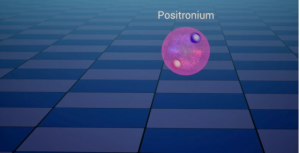ForumIAS announcing GS Foundation Program for UPSC CSE 2025-26 from 19 April. Click Here for more information.
ForumIAS Answer Writing Focus Group (AWFG) for Mains 2024 commencing from 24th June 2024. The Entrance Test for the program will be held on 28th April 2024 at 9 AM. To know more about the program visit: https://forumias.com/blog/awfg2024
Source– This post on Laser cooling of Positronium at CERN has been created based on the article “In a first, CERN scientists carry out laser cooling of Positronium” published in “The Indian Express” on 23 February 2024.
Why in the news?
An international team of physicists from the Anti-hydrogen Experiment: Gravity, Interferometry, Spectroscopy (AEgIS) collaboration has recently achieved a breakthrough by demonstrating the laser cooling of Positronium.
About Positronium

| Aspect | Details |
| Description | It is a fundamental atomic system that comprises a bound electron (e-) and positron (e+). |
| Properties | Mass-Its mass is twice the electron mass and enjoys the unique distinction of being a pure leptonic atom. Half life-Due to its very short life, it annihilates with a half life of 142 nano-seconds. |
| Significance | This hydrogen-like system, with halved frequencies for excitation, makes it useful for attempting laser cooling. This can help in performing tests of fundamental theories in physics. |
What is AEgIS experiment?
Antihydrogen Experiment: Gravity, Interferometry, Spectroscopy (AEgIS) is the direct measurement of the Earth’s gravitational acceleration on antihydrogen.
AEgIS is a collaboration of physicists from a number of countries in Europe and from India. This team has achieved a breakthrough by demonstrating the laser cooling of Positronium.
How was laser cooling of Positronium achieved?
Experimentalists achieved laser cooling of Positronium atoms initially from ~380 Kelvin to ~170 Kelvin, and demonstrated the cooling in one dimension using a 70-nanosecond pulse of the alexandrite-based laser system.
The lasers deployed were either in the deep ultraviolet or in the infrared frequency bands
What is the significance of laser cooling of Positronium?
1) Measurement of Earth’s gravitational acceleration– This is an important precursor experiment to the formation of anti-Hydrogen and the measurement of Earth’s gravitational acceleration on antihydrogen in the AEgIS experiment.
2) Gamma-ray laser– It could open prospects to produce a gamma-ray laser that would eventually allow researchers to look inside the atomic nucleus and have applications beyond physics.
3) Quantum Electrodynamics (QED)– It will pave the way for performing spectroscopic comparisons required for the Quantum Electrodynamics (QED), the study of the light and its interaction with charged matter.
4) Bose–Einstein condensate– It allows the production of a positronium Bose–Einstein condensate, in which all constituents occupy the same quantum state. It can be an incredible tool for both fundamental and applied research.
Read more about –CERN
UPSC Syllabus-Science & Technology.




